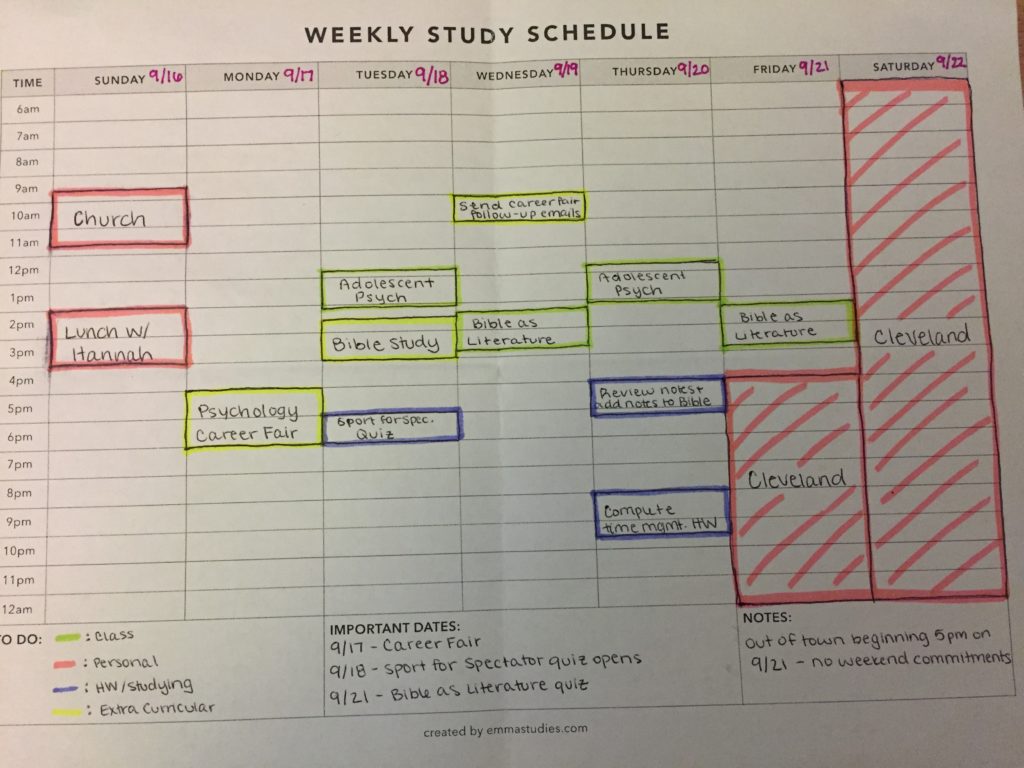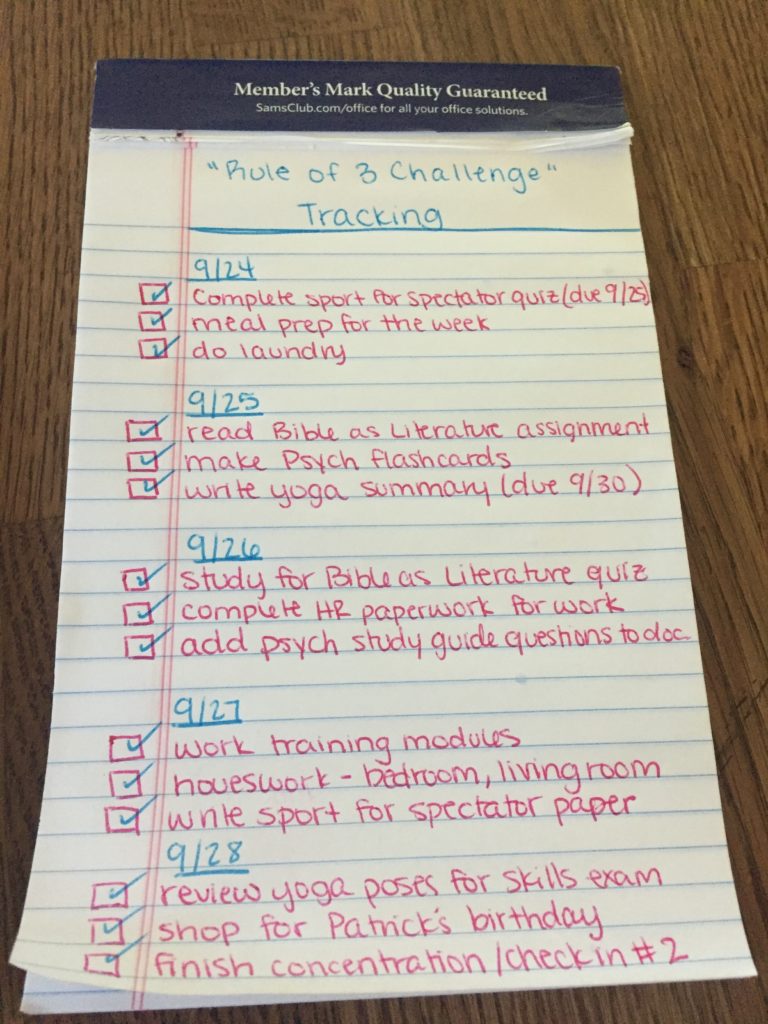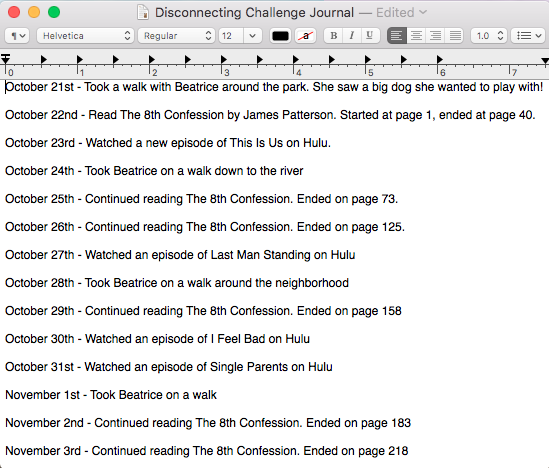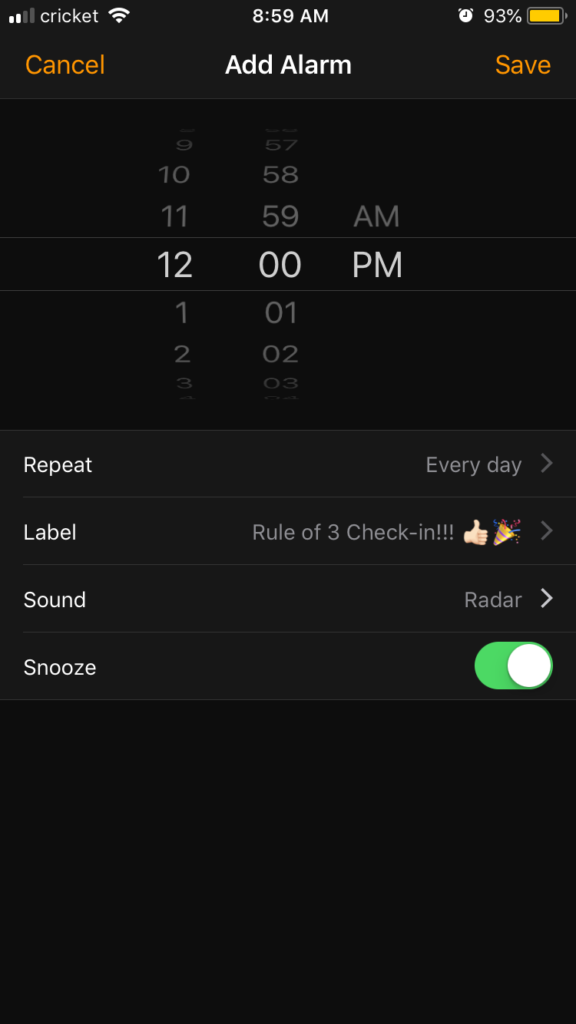Something a lot of college students struggle with is productivity. After taking ESEPSY 1259 and reading The Productivity Project by Chris Bailey, I experimented with different productivity boosting strategies. As I focused on this project my goals were to increase my productivity by achieving three tasks, academic and non-academic, each day. Reading The Productivity Project helped me to think about productivity in different ways through different challenges and finding which methods were most useful to me. Throughout this post I will share with you the strategies that I have found work best for me. I will outline the strategies, share why they work and how to implement them, and provide you with a visual example to help you on your road to better productivity.
Strategy #1 – Time Blocking Calendar
I am a visual learner. I need to see things clearly laid out on paper in order to learn best. One thing that helped me visualize my time and make it as productive as it could be was using a time blocking calendar. You can find different templates online, or create your own, whatever works best for you. I used one I found online in a format that made the most sense to me. On my own time blocking calendar, I first started by adding all of the consistent obligations I have week-to-week. These include classes, meetings, work, and church. Then, I added obligations that were unique to that week, such as lunch with a friend, a study group meeting, or a trip out of town. Finally, I added reminders of any deadlines I had that week. Everything on my time blocking calendar was color coded according to school, extracurricular, personal, and homework or studying. If you are a visual learner like myself, using the time blocking calendar strategy should help you really know what is going on in your week in order to plan your time most effectively for optimal productivity. If you schedule in the tasks you want to complete it can help you to feel like it’s more of a time-sensitive matter than a task you can put off until the last second. It also allows you the ability to schedule in your personal time so you know that you’re both accomplishing your tasks and having down-time.

Strategy #2 – The Rule of 3 Challenge
One of the strategies that really stood out to me when reading The Productivity Project was the Rule of 3 challenge. Author Chris Bailey talks about how you can increase your productivity by narrowing down all the tasks you have to do in a day into a list of three things you want to accomplish. I found that sometimes this task was a little difficult for me because I didn’t always have a lot of schoolwork to do, but I realized that I could allocate time on certain days to getting housework or grocery shopping done – productivity doesn’t just have to be about schoolwork! On some days I only had a list of one or two items I needed to accomplish. I also realized how important it was to give myself a day off here and there to rest. Sometimes the key to productivity is not overworking ourselves and allowing ourselves to have a day where what we accomplish is good enough and we don’t always have to stick to a list. By allowing ourselves to have relaxed, unstructured days, we feel refreshed and renewed to get back to work and making these lists and being productive the next day. If you struggle with finding a balance between work and school, try to include both academic and non-academic tasks in your list of three tasks. If you put all of your focus on academics and let other chores fall by the wayside, make your list geared toward non-academic tasks. If you find it hard to accomplish your academic tasks because you’re focused on running errands and doing chores, create a list of academic tasks you need to get through. Use this challenge in a way that will best help you in achieving your goals of productivity.

Strategy #3 – The Disconnecting Challenge
When we think of productivity we often think of a day spent accomplishing all of the tasks we need to do. What we tend not to associate with productivity is taking time for ourselves. We can’t possibly be productive if we’re enjoying me-time, can we? In The Productivity Project, Bailey talks about the importance of taking 30 minutes each day for yourself. This increases productivity by giving yourself time to refresh and rejuvenate, which allows you to feel more ready and prepared to accomplish tasks during the rest of your day. What you do in your 30 minutes is entirely up to you. You could go on a walk, get a workout in, watch an episode of something on Netflix, read a book, play with your dog, meditate, cook,… the list goes on. As long as what you do in your 30 minutes is purely for you and not for anyone else or is anything that fulfills another obligation, you can do it. You can do the same thing every day or you can change it up and make it a variety. I tracked my 30 minutes by journaling a sentence or two each day about what I did. Some tracking methods that you can try are journaling, making an Instagram page to take a photo of what you do each day, or create a bullet list with the date and activity. This challenge is all about doing something for yourself and making a habit of it, so customize it in a way that works best for you to help you relax!

Strategy #4 – Accountability
It takes time to create new habits, and if you’re not in the habit of using these strategies already it will not necessarily be easy at first. A way that you can hold yourself accountable in these challenges is to set reminders on your phone. You might not need to set a reminder for all of them. Personally, I only had a reminder in my phone for the Rule of 3 Challenge. I set a mid-day reminder to check in and determine where I was in accomplishing my three tasks. If I hadn’t accomplished any of the tasks, I knew I had to make them a better priority in my day. However, if I had accomplished all of them then I knew that, regardless of how much else I accomplished that day, I could be content knowing that I accomplished the three set tasks. I didn’t set a reminder for the Disconnecting Challenge, because each day looks different for me, so I couldn’t set a reminder that would work every day. Instead, when I sat down each day to decide what my three tasks were for the Rule of 3, I would also look at my day and determine an ideal time to take my 30 minute break. If you have a consistent day-to-day schedule, a phone reminder for Disconnecting might be beneficial to you. For the time blocking calendar, you could set a reminder on Saturdays to sit down and map out your calendar for the coming week. I think phone reminders are beneficial because it’s so easy to get caught up in our days that we can lose track of our goals and to-do lists for each day. A phone reminder is a good way to keep yourself accountable and check in to see how well you’re doing staying on task. Above all else, when it comes to accountability, find something that works best for you and stick with it until these strategies become part of the habits of your daily life!

Takeaways
This semester I learned that productivity is not just one thing. Productivity does not mean that we set out to accomplish a long list of tasks and are only successful if we complete everything on the list. Productivity does not mean that we devote our entire days to everything but ourselves. Productivity means that sometimes we will have days where we accomplish everything on our list, and other days we don’t, and that’s okay. Productivity means that it’s okay to take time for ourselves so we don’t get burnt out. Productivity means it’s okay to break down our overwhelming to-do lists into manageable chunks. I will take these insights into the meaning of productivity with me in everything that I do in life. I encourage you to try out the strategies I’ve shared to see if any of them work for you. I also advise you to read The Productivity Project, by Chris Bailey, and learn about the countless other strategies he outlines in his book. You never know what will work best for you unless you try, but once you find something that works for you, stick with it!
